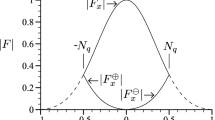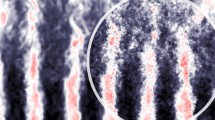Abstract
Image deformation methods in particle image velocimetry are becoming more and more accepted by the scientific community but some aspects have not been thoroughly investigated neither theoretically nor with the aid of simulations. A fundamental step in this type of algorithm is reconstruction of the deformed images that requires the use of an interpolation scheme. The aim of this paper is to examine the influence of this aspect on the accuracy of the PIV algorithm. The performance assessment has been conducted using synthetic images and the results show that both the systematic and total errors are strongly influenced by the interpolation scheme used in the reconstruction of the deformed images. Time performances and the influence of particle diameter are also analysed.













Similar content being viewed by others
Notes
In many previous works this point is not described in detail, so it is difficult to clearly understand who was the first to propose the two approaches.
Of course the time t is a function of the computer used during the simulation so it should be regarded as a relative measurement.
Abbreviations
- BSPLM:
-
interpolation scheme based on the B-spline of order M
- FFT:
-
fast Fourier transform
- FFTM:
-
interpolation scheme based on the shift theorem of the Fourier transform using M xM points
- IDM:
-
image deformation methods
- IDWO:
-
iterative discrete window offset
- IS:
-
interpolation scheme(s)
- PID:
-
particle image distortion
- PIV:
-
particle image velocimetry
- SINCM:
-
interpolation scheme based on the sinc formula using M xM points
- D :
-
particle diameter, pixels
- f :
-
grey intensity of the first image, dimensionless
- g :
-
grey intensity of the second image, dimensionless
- i :
-
horizontal image coordinate (integer value), pixels
- j :
-
vertical image coordinate (integer value), pixels
- l :
-
horizontal shift, pixels
- m :
-
vertical shift, pixels
- N :
-
number of measurement points, dimensionless
- N I :
-
number of particles per interrogation window, dimensionless
- r :
-
displacement field, pixels
- r c :
-
corrector displacement field, pixels
- r w :
-
displacement field averaged over the interrogation window, pixels
- t :
-
time needed to perform deformation of the images, seconds
- ū :
-
mean measured displacement, pixels
- u :
-
imposed displacement, pixels
- u i :
-
local measured displacement, pixels
- W :
-
interrogation window linear dimension, pixels
- x :
-
horizontal image coordinate, pixels
- y :
-
vertical image coordinate, pixels
- \( \overline{\beta } \) :
-
mean bias error, pixels
- β :
-
bias error, pixels
- \( \overline{\sigma } \) :
-
mean total error, pixels
- δ :
-
total error, pixels
- μ :
-
mean operator
- ϕ lm :
-
cross-correlation coefficient, dimensionless
- σ :
-
random error, pixels
- k :
-
iteration counter, dimensionless
References
Gui L, Wereley ST (2002) A correlation-based continuous window-shift technique to reduce the peak-locking effect in digital PIV image evaluation. Exp Fluids 32:506–517
Hart DP (2000) Super-resolution PIV by recursive local-correlation. J Visual 3(2):187–194
Huang HT, Fiedler HE, Wang JJ (1993) Limitation and improvement of PIV, part 2. Particle image distortion, a novel technique. Exp Fluids 15:263–273
Jambunathan K, Ju XY, Dobbins BN, Ashforth-Frost S (1995) An improved cross correlation technique for particle image velocimetry. Meas Sci Technol 6:507–514
Keane RD, Adrian RJ (1993) Theory of cross correlation analysis of PIV images. In: Nieuwstadt FTM (ed) Flow visualization and image analysis. pp 1–25
Lecordier B, Demare D, Vervisch LMJ, Rèveillon J, Trinitè M (2001) Estimation of the accuracy of PIV treatments for turbulent flow studies by direct numerical simulation of multi-phase flow. Meas Sci Technol 12:1382–1391
Meunier P, Leweke T (2003) Analysis and treatment of errors due to high velocity gradients in particle image velocimetry. Exp Fluids 35:408–421
Nogueira J, Lecuona A, Rodriguez PA (1999) Local field correction PIV: on the increase of accuracy of digital PIV systems. Exp Fluids 27:107–116
Nogueira J, Lecuona A, Rodriguez PA (2001) Local field correction PIV, implemented by means of simple algorithms, and multigrid versions. Meas Sci Technol 12:1911–1921
Raffel M, Willert CE, Kompenhans J (1998) Particle image velocimetry: a practical guide. Springer, Berlin Heidelberg New York
Scarano F (2002) Iterative image deformation methods in PIV. Meas Sci Technol 13:R1–R19
Scarano F (2004) A super-resolution particle image velocimetry interrogation approach by means of velocity second derivatives correlation. Meas Sci Technol 15:475–486
Scarano F, Riethmuller ML (1999) Iterative multigrid approach in PIV image processing with discrete window offset. Exp Fluids 26:513–523
Scarano F, Riethmuller ML (2000) Advances in iterative multigrid PIV image processing. Exp Fluids S51–S60
Soria J (1996) An investigation of the near wake of a circular cylinder using a video-based digital cross-correlation particle image velocimetry technique. Exp Therm Fluid Sci 12:221–233
Unser M (1999) Splines: a perfect fit for signal and image processing. IEEE Signal Proc Mag 16(6):22–38
Unser M, Aldroubi A, Eden M (1993a) B-spline signal processing: part I—theory. IEEE T Signal Proces 41(2):821–832
Unser M, Aldroubi A, Eden M (1993b) B-spline signal processing: part II—efficient design and applications. IEEE T Signal Proces 41(2):834–848
Utami T, Blackwelder RF, Ueno T (1991) A cross-correlation technique for velocity field extraction from particulate visualization. Exp Fluids 10:213–223
Wereley ST, Meinhart CD (2001) Second-order accurate particle image velocimetry. Exp Fluids 31:258–268
Westerweel J (1993) Digital particle image velocimetry—theory and applications. PhD Thesis, Delft University of Technology, The Netherlands
Westerweel J (2000) Theoretical analysis of the measurement precision in particle image velocimetry. Exp Fluids 29:S3–S12
Westerweel J, Dabiri D, Gharib M (1997) The effect of a discrete window offset on the accuracy of cross-correlation analysis of digital PIV recordings. Exp Fluids 23:20–28
Willert CE, Gharib M (1991) Digital particle image velocimetry. Exp Fluids 10:181–193
Yaroslavsky LP (1996) Signal sinc-interpolation: a fast computer algorithm. Bioimaging 4:225–231
Author information
Authors and Affiliations
Corresponding author
Rights and permissions
About this article
Cite this article
Astarita, T., Cardone, G. Analysis of interpolation schemes for image deformation methods in PIV. Exp Fluids 38, 233–243 (2005). https://doi.org/10.1007/s00348-004-0902-3
Received:
Accepted:
Published:
Issue Date:
DOI: https://doi.org/10.1007/s00348-004-0902-3




